| Bakupari - Garcinia brasiliensis | |
|---|---|
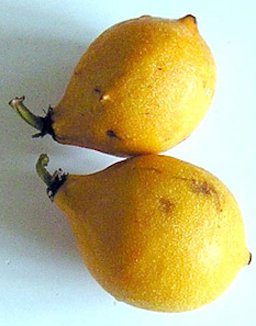 Fig. 1 Bakupari, Garcinia brasiliensis  Fig. 2  Leaves growth habit 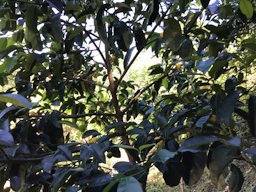 Fig. 3  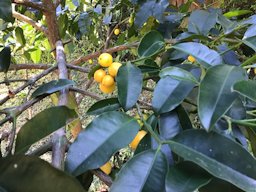 Fig. 4  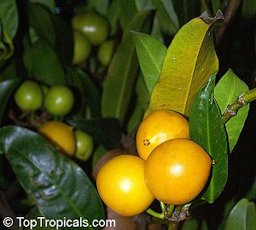 Fig. 5  Fruit 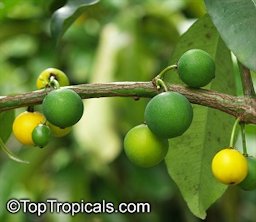 Fig. 6  Fruit habit |
Scientific
name Garcinia brasiliensis C. Mart. Common names Brazil: bacupari, bacupari-miúdo, bacuparizinho; Bolivia: guapomo 2,7 Synonym Rheedia brasiliensis (Mart.) Planch. & Triana, R. floribunda "sensu" Engler, G. floribuna "susu" Miq. 7 Relatives Bakuri (Platonia insignis); bacupari (G. gardneriana); cherapu (G. prainiana); bacuripari (G. macrophylla); Cuban mangosteen (G. aristata); gamboge (G. xanthochymus); imbe (G. livinstonei); lemon drop mangosteen (G. intermedia); madroño (G. madruno); also called madroño (G. magnifolia); mameyito (G. edulis) Family Clusiaceae (St. John’s wort family) alt. Guttiferae Origin Indigenous to the state of Rio de Janeiro in southeastern Brazil 5 Uses Fruit eaten out of hand or made into jam; Height 13- 26 ft (4-8 m) 7 Crown Dense, rounded crown 2,7 Plant habit Small evergreen tree 2,7 Growth rate Fairly slowly Trunk/bark/branches Young branches angular; brownish coarse bark (Fig. 3) 7 USDA hardiness zones 10-12 Leaves Short-petioled; ovate, oblong-ovate or lanceolate; narrowed at the base; blunt or slightly pointed at the apex; leathery 2 Flowers Profuse in axillary clusters; polygamous; white; aromatic 2,7 Fruit Drupe; ovate; pointed at the apex; yellow or orange; sub-acid; excellent flavor 2,7 Season Jan., Feb. in Brazil Light requirement Succeeds in full sun or light shade 7 Invasive potential * None reported Reading Material Bakupari, Fruits of Warm Climates Bakupari, Manual Of Tropical And Subtropical Fruits There are over 250 Garcinia species, mostly from southeast Asia. Garcinia species from the Americas were once classified as Rheedia, but now all are considered Garcinia. This taxon is a little confused with Garcinia humilis. The confusion revolves in part around Rheedia laterifolia and Rheedia lateriflora. Indeed all these names could be synonymous. They have a common Spanish name "Achachairú", a Guraní Indian term which translates as “honey kiss”, also shared with other species as well. "There is a feeling" that Rheedia brasiliensis is a Brazilian species whilst Garcinia humilis is more of Bolivian origin. All this remained to be confirmed. 1 Sorting Garcinia Names, Multilingual Multiscript Plant Name Database, University of Melbourne, Australia ext. link Origin South America: Argentina, Paraguay, eastern Brazil, Bolivia, Peru, French Guiana. Mainly found in secondary forests, by rivers, floodplains, coastal moist broad-leaved forests etc. 3 Description The very attractive tree is pyramidal like that of the bakuri but smaller; is equally rich in yellow latex. The tree grows wild in the state of Rio de Janeiro in southeastern Brazil and adjacent Paraguay; is rarely cultivated. It blooms in December and matures its fruit in January and February. 2 Leaves Short-petioled, ovate, oblong-ovate or lanceolate, narrowed at the base, blunt or slightly pointed at the apex, and leathery. 2 Flowers Inflorescences: male flowers are more numerous along with 3-5 androgynous flowers per inflorescence on fascibles with a verticillate aspect. 4 Fruit The fruit, ovate, pointed at the apex, may be 1 1/4 to 1 1/2 in (3.2-4 cm) long, with orange-yellow, pliable, leathery, tough skin, 1/8 in (3 mm) thick and easily removed. The aril-like pulp is white, translucent, soft, sub-acid, of excellent flavor, and encloses 2 rounded seeds. 2 Propagation To obtain seeds, the fruits must be collected directly from the trees when they mature, or gathered from the ground when they fall naturally. Seeds should be planted just after collection. Emergence takes 15-25 days with a germination rate above 50%. 7 Food Uses Fresh and to make jam. The tree is widely cultivated in home gardens throughout the country. Medicinal Properties ** The seeds contain 8 to 9% oil (by weight) which is used in Brazil in poultices on wounds, whitlows, tumors and, externally, over an enlarged liver. An infusion of the pulp has a narcotic action with an effect like that of nicotine. The root bark extract contains rheediaxanthone and a polyprenylated benzophenone, other lesser constituents, and 3 new prenylated xanthones. 2 Other Edible Garcinia species: Achachairu, G. humilis Bacuripari, G. macrophylla Cherapu (button mangosteen), G. prainiana Gamboge (false mangosteen), G. xanthochymus Imbe (African mangosteen), G. livinstonei Lemon Drop Mangosteen, G. intermedia Madrono, G. madruno List of Growers and Vendors |
| Bibliography 1 "Sorting Rheedia Names." Multilingual Multiscript Plant Name Database, M.M.P.N.D., plantnames.unimelb.edu.au. Accessed 11 Jan. 2015. 2 Fruits of Warm Climates. Julia F. Morton, Miami, 1987. 3 "Garcinia brasiliensis." Tropical Plant Database, (CC BY-NC-SA 3.0), tropical.theferns.info. Accessed 14 Jan. 2015. 4 Lorenzi, Harri, et al. Brazillian Fruits & Cultivated Exotics (for consuming in natura). Nova Odessa, Instituto Plantarum de Estudos da Flora, 2006. 5 Popenoe, Wilson. Manual Of Tropical And Subtropical Fruits. 1920, London, Hafner Press, 1974. 6 "Garcinia brasiliensis Mart. synonyms." World Flora Online, 2021, WFO, Public Domain, www.worldfloraonline.org/search?query=Garcinia+brasiliensis+synonyms&limit=24&start=0&sort=. Accessed 29 Apr. 2021. 7 Lorenzi, Harri. Brazilian Trees, A Guide to the Identification and Cultivation of Brazilian Native Trees. Vol. 3. Nova Odessa, Instituto Plantarum de Estudos da Flora, 2009. Photographs Fig. 1 Carolqk. "Fruta do Bacupari (Garcinia gardneriana). Sao Paulo, Brazil." Wikimedia Commons, 2006, commons.wikimedia.org. Accessed 14 Jan. 2015. Fig. 2,5,6 "Rheedia brasiliensis, Rheedia laterifolia, Garcinia laterifolia." Top Tropicals, toptropicals.com. Accessed 1 June 2014. Fig. 3,4 aapasa. "Garcinia brasiliensis. Peru." iNaturalist Research Grade, 8 Mar. 2021, (CC BY-NC 4.0), www.inaturalist.org/observations/70837967. Accessed 2 May 2021. * UF/IFAS Assessment of Non-native Plants in Florida's Natural Areas ** Information provided is not intended to be used as a guide for treatment of medical conditions. Published Feb. 2014 LR. Last update 12 Dec. 2023 LR |
|